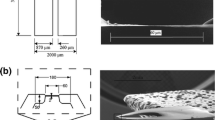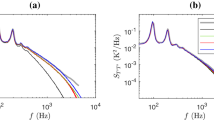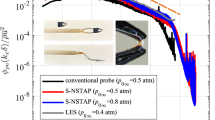Abstract
A new method for measuring turbulent heat fluxes using a combination of particle image velocimetry and a nanoscale fast-response cold-wire is tested by examining a rough-wall turbulent boundary layer subject to weakly stable stratification. The method has the advantages of simple calibration and setup, as well as providing spatial correlations of velocity and temperature and their associated integral length scales. The accuracy of using Taylor’s hypothesis when employing a large field of view is investigated. Heat flux, velocity–temperature correlation coefficients and turbulent Prandtl number profiles, as well as spatial velocity and temperature correlations, are presented.










Similar content being viewed by others
References
Adrian R, Meinhart C, Tomkins C (2000) Vortex organization in the outer region of the turbulent boundary layer. J Fluid Mech 422:1–54
Arwatz G, Bahri C, Smits AJ, Hultmark M (2013) Dynamic calibration and modeling of a cold wire for temperature measurement. Meas Sci Tech 24(12):125301
Arwatz G (2015) Investigations of the fundamentals of passive scalar dynamics using nano-sensing devices, PhD Thesis. Princeton University, Princeton
Arya S (1974) Buoyancy effects in a horizontal flat plate boundary layer. J Fluid Mech 68:321–343
Atkinson C, Buchmann N, Soria J (2015) An experimental investigation of turbulent convection velocities in a turbulent boundary layer. Flow Turbul Combust 94:79–95
Bardet P, André M, Neal D (2013) Systematic timing errors in laser-based transit-time velocimetry. In: PIV13; 10th international symposium on particle image velocimetry, Delft, The Netherlands, July 1–3
Fan Y, Arwatz G, Van Buren TW, Hoffman DE, Hultmark M (2015) Nanoscale sensing devices for turbulence measurements. Exp Fluids 56:138. doi:10.1007/s00348-015-2000-0
Fulachier L (1972) Contribution à l’étude des analogies des champs dynamiques et thermiques dans une couche limite turbulente. Effet de l’aspiration. PhD thesis, Université de Provence, Aix-Marseille
Geng C, He G, Wang T, Xu C, Lozano-Durán A, Wallace JM (2015) Taylor’s hypothesis in turbulent channel flow considered using a transport equation analysis. Phys Fluids 27(2):025111
Heist D, Castro I (1998) Combined laser-doppler and cold wire anemometry for turbulent heat flux measurement. Exp Fluids 27:375–381
Huang H, Fiedler H, Wang J (1993) Limitation and improvement of PIV. II—particle image distortion, a novel technique. Exp Fluids 15:168–174
Jambunathan K, Ju X, Dobbins B, Ashforth-Frost S (1995) An improved cross-correlation technique for particle image velocimetry. Meas Sci Technol 6(5):507
Katul G, Porporato A, Shah S, Bou-Zeid E (2014) Two phenomenological constants explain similarity laws in stably stratified turbulence. Phys Rev E 89(2):023007
Nogueira J, Lecuona A, Rodriguez P (1999) Local field correction PIV: on the increase of accuracy of digital PIV systems. Exp Fluids 27(2):107–116
Ohya Y, Neff D, Meroney R (1996) Turbulence structure in a stratified boundary layer under stable conditions. Bound Layer Meteorol 83:139–161
Perry A, Hoffmann P (1976) An experimental study of turbulent convective heat transfer from a flat plate. J Fluid Mech 77(2):355–368
Prasad A, Adrian R, Landreth C, Offutt P (1992) Effect of resolution on the speed and accuracy of particle image velocimetry interrogation. Exp Fluids 13(2–3):105–116
Scarano F (2002) Iterative image deformation methods in PIV. Meas Sci Technol 13(1):R1–R19
Smits AJ, Perry AE (1981) A note on hot-wire anemometer measurements of turbulence in the presence of temperature fluctuations. J Phys E Sci Instrum 14:311–312
Smits AJ, Perry AE, Hoffmann PH (1978) The response to temperature fluctuations of a constant current hot-wire anemometer. J Phys E Sci Instrum 11:909–914
Soria J (1996) An investigation of the near wake of a circular cylinder using video-based digital cross-correlation particle image velocimetry technique. Exp Thermal Fluid Sci 12(2):221–233
Tavoularis S, Corrsin S (1981) Experiments in nearly homogenous turbulent shear flow with a uniform mean temperature gradient. Part 1. J Fluid Mech 104:311–347
Taylor GI (1938) The spectrum of turbulence. Proc R Soc Lond 164(919):476–490
Thole K, Bogard DG (1994) Simultaneous temperature and velocity measurements. Meas Sci Technol 5(4):435–439
Weiss F, Paranthoën P, Lecordier JC (2005) Frequency response of a cold-wire in a flow seeded with oil particles. Exp Fluids 39:935–940
Westerweel J, Scarano F (2005) Universal outlier detection for PIV data. Exp Fluids 39(6):1096–1100
Willert C, Gharib M (1991) Digital particle image velocimetry. Exp Fluids 10(4):181–193
Williams O (2014) Density effects on turbulent boundary layer structure: from the atmosphere to hypersonic flow. PhD thesis, Princeton University, Princeton
Wu Y, Christensen K (2006) Population trends of spanwise vortices in wall turbulence. J Fluid Mech 568:55–76
Acknowledgments
This work was supported by the Cooperative Institute for Climate Science (CICS) at Princeton University. We would also like to thank Yuyang Fan, Gilad Arwatz and Marcus Hultmark who provided the T-NSTAP used in this study.
Author information
Authors and Affiliations
Corresponding author
Additional information
This article belongs to a Topical Collection of articles entitled Extreme Flow Workshop 2014. Guest editors: I. Marusic and B. J. McKeon.
Rights and permissions
About this article
Cite this article
Williams, O., Van Buren, T. & Smits, A.J. A new method for measuring turbulent heat fluxes using PIV and fast-response cold-wires. Exp Fluids 56, 142 (2015). https://doi.org/10.1007/s00348-015-2008-5
Received:
Revised:
Accepted:
Published:
DOI: https://doi.org/10.1007/s00348-015-2008-5




